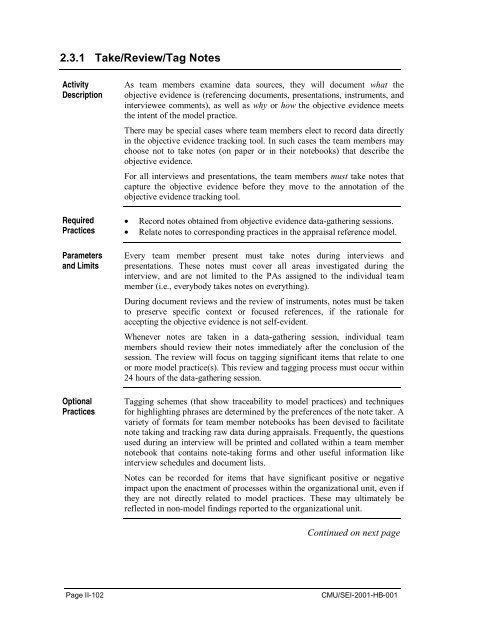Standard CMMI Appraisal Method for Process Improvement (SCAMPI)
Standard CMMI Appraisal Method for Process Improvement (SCAMPI)
Standard CMMI Appraisal Method for Process Improvement (SCAMPI)
Create successful ePaper yourself
Turn your PDF publications into a flip-book with our unique Google optimized e-Paper software.
2.3.1 Take/Review/Tag Notes<br />
Activity<br />
Description<br />
Required<br />
Practices<br />
Parameters<br />
and Limits<br />
Optional<br />
Practices<br />
As team members examine data sources, they will document what the<br />
objective evidence is (referencing documents, presentations, instruments, and<br />
interviewee comments), as well as why or how the objective evidence meets<br />
the intent of the model practice.<br />
There may be special cases where team members elect to record data directly<br />
in the objective evidence tracking tool. In such cases the team members may<br />
choose not to take notes (on paper or in their notebooks) that describe the<br />
objective evidence.<br />
For all interviews and presentations, the team members must take notes that<br />
capture the objective evidence be<strong>for</strong>e they move to the annotation of the<br />
objective evidence tracking tool.<br />
• Record notes obtained from objective evidence data-gathering sessions.<br />
• Relate notes to corresponding practices in the appraisal reference model.<br />
Every team member present must take notes during interviews and<br />
presentations. These notes must cover all areas investigated during the<br />
interview, and are not limited to the PAs assigned to the individual team<br />
member (i.e., everybody takes notes on everything).<br />
During document reviews and the review of instruments, notes must be taken<br />
to preserve specific context or focused references, if the rationale <strong>for</strong><br />
accepting the objective evidence is not self-evident.<br />
Whenever notes are taken in a data-gathering session, individual team<br />
members should review their notes immediately after the conclusion of the<br />
session. The review will focus on tagging significant items that relate to one<br />
or more model practice(s). This review and tagging process must occur within<br />
24 hours of the data-gathering session.<br />
Tagging schemes (that show traceability to model practices) and techniques<br />
<strong>for</strong> highlighting phrases are determined by the preferences of the note taker. A<br />
variety of <strong>for</strong>mats <strong>for</strong> team member notebooks has been devised to facilitate<br />
note taking and tracking raw data during appraisals. Frequently, the questions<br />
used during an interview will be printed and collated within a team member<br />
notebook that contains note-taking <strong>for</strong>ms and other useful in<strong>for</strong>mation like<br />
interview schedules and document lists.<br />
Notes can be recorded <strong>for</strong> items that have significant positive or negative<br />
impact upon the enactment of processes within the organizational unit, even if<br />
they are not directly related to model practices. These may ultimately be<br />
reflected in non-model findings reported to the organizational unit.<br />
Continued on next page<br />
Page II-102<br />
CMU/SEI-2001-HB-001
















